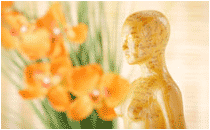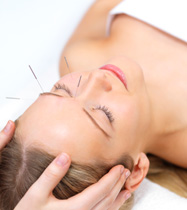ACUPUNCTURE
More Services |
||
|---|---|---|

Jade Spring Wellness Center offers individually-tailored acupuncture treatments in a beautiful and relaxing environment. Our practitioners utilize a holistic, team approach to your care. Each practitioner is highly trained in many of the modalities used in Traditional Chinese Medicine and will consult with you to select the treatment most suitable for your condition and constitution.
Acupuncture can effectively treat a wide variety of acute and chronic conditions including, but not limited to:
| Addictions Allergies Arthritis Asthma Back Pain Carpal Tunnel Chemo Nausea Chronic Pain Colds Depression Digestive Problems Ear Problems Facial Rejuvenation Whiplash injuries |
Fatigue Fibromyalgia Flu Headaches Hypertension Immune Diseases Insomnia Joint Pain Menopause Muscle Pain PMS Urinary Problems Weight Loss |
The U.S. National Institutes of Health (NIH) and the World Health Organization (WHO) have declared acupuncture effective for these and more than 200 other conditions:

- Circulatory disorders -- Hypertension, palpitations, heart disease
- Disorders of the bones, muscles, and joints -- Headaches, low back pain, neck and shoulder pain, joint pains, injuries, numbness and tingling, muscular aches and pains, osteoarthritis
- Disorders of the nervous system-- Multiple sclerosis, post-stroke conditions
- Emotional and psychological disorders --Depression, anxiety
- Gastrointestinal disorders--Indigestion, pain, nausea/vomiting, diarrhea constipation, eating disorders
- Gynecological disorders-- Irregular, heavy, or painful menstruation, premenstrual syndrome, menopausal problems, fertility issues
- Immune disorders--Chronic fatigue, HIV/AIDS
- Pregnancy-related complaints--Morning sickness, edema, fatigue
- Respiratory disorders--Chronic colds, coughs, asthma, allergies
- Sleep and stress disorders--Nervous tension, insomnia, low energy
- Urogenital disorders--Urinary tract problems, sexual dysfunction
Frequently Asked Questions about Acupuncture
The positive effects of acupuncture begin right away at your first visit. As we progress through a course of acupuncture therapy the amount of symptom relief and the time period of increased wellness following each treatment will become more pronounced, until your body holds the changes on its own. It is important to be consistent with frequent visits at the beginning of care in order to build momentum and hold the gains we make from visit to visit.
While some patients obtain quick relief from 3-4 treatments, most patients require 6-12 treatments to make significant changes. To consolidate gains made and prevent relapse, follow up treatments may be necessary based on the condition. While acute conditions may resolve within just a few visits, chronic conditions that have persisted for many years may take more treatments over a longer period of time to completely resolve.
If there is a time of day that works best for your appointments we encourage you to schedule several visits in advance to hold your ideal appointment times. If you need to cancel appointments please give advance notice so that we may give that time to other patients. We ask that you reschedule promptly so that a long absence does not interrupt the rhythm of your care.
We suggest having a meal within a couple of hours before your visits, or at least a snack on the way to the clinic. Additionally, we suggest refraining from intense physical activity, alcohol or caffeine for 4 hours after each visit. You may prefer to bring shorts or loose clothing.
Chinese herbs combine synergistically with acupuncture and have been safely used for over 2500 years to accelerate the healing process. The companies we use offer the highest quality ingredients and products are subject to stringent testing and are FDA and GMP compliant. Like acupuncture, herbs work best when taken consistently at the recommended dose. Any recommended dietary supplements are based on modern research and we stock only the highest quality brands.
Most patients seek treatment because they are in enough discomfort to do something about it. We cluster visits close together during this acute phase of treatment to reduce the level of symptoms as quickly as possible.
Once we have brought the level of discomfort down we begin to lengthen the interval of time between visits. Continuing care through this phase allows the healing process to occur and helps the body to consolidate the positive effects of the acupuncture so that backsliding does not occur. During this phase it is common to want to “test it out” or overdo it because of the relative absence of discomfort, however, it is important to remember that although the pain is lessened, the healing process is still unfolding and the body is vulnerable to re-injury or re-aggravation of symptoms.
Patients with chronic conditions or symptoms that tend to recur may also require an ongoing maintenance interval. Many patients find it helpful to come in for a “tune-up” treatment every so often. This can vary from bi-weekly to monthly visits.
Jade Spring Wellness Center Treatment modalities and techniques include:
What is the scientific basis for acupuncture?
Scientific research is attempting to understand the mechanism of acupuncture. At this point researchers are able to measure activity in specific various body systems when an acupuncture needle is inserted: 1) increase in peripheral blood flow, 2) increase in the neural pain threshold, 3) release of neurochemicals similar to endorphins, which also play a big role in the functioning of the hormonal system, 4) increase in T cells and other immune constituents, 5) increased activity at nerve “gates”. The hypothalamus-pituitary glands are responsible for releasing neurotransmitters and endorphins, the body's natural pain-killing hormones. It is estimated that endorphins are 200 times more potent than morphine. Endorphins also play a big role in the functioning of the hormonal system. Thermal PET scans also show activity in the regions of the brain responsible for “pain” messages. However, the logic of the meridian network continues to elude scientific observation.
What is the traditional theory behind acupuncture?
The meridian network is like a road map superimposed over the body with highways, secondary roads, on and off ramps, etc running throughout the body. One could also think of it in terms of an energetic irrigation system carrying “Qi” (pronounced “chee”, meaning “vital energy”) to nourish all areas of the body. The smooth flow of Qi is essential for good health and for healing. When the flow of Qi becomes obstructed, like a kink in the garden hose, symptoms can occur. Restoring the flow of Qi through the meridians using acupuncture helps bring the body back into balance and facilitates the natural healing process.
The substances released as a result of acupuncture not only relax the whole body, they regulate serotonin in the brain which plays a role in human and animal disposition. This is why depression is often treated with acupuncture.
Electroacupuncture is quite similar to traditional acupuncture in that the same points are stimulated during treatment. As with traditional acupuncture, needles are inserted on specific points along the body. The needles are then attached to a device that generates continuous electric pulses using small clips. These devices are used to adjust the frequency and intensity of the impulse being delivered, depending on the condition being treated. Electroacupuncture uses two needles at time so that the impulses can pass from one needle to the other. Several pairs of needles can be stimulated simultaneously, usually for no more than 30 minutes at a time.
According to the principles of traditional Chinese medicine, illness is caused when Qi does not flow properly throughout the body. Acupuncturists determine whether Qi is weak, stagnant or otherwise out of balance, which indicates the points to be stimulated. Electroacupuncture is considered to be especially useful for conditions in which there is an accumulation of Qi, such as in chronic pain syndromes, or in cases where the Qi is difficult to stimulate.
 Moxibustion is a traditional Chinese medicine technique that involves the burning of mugwort, a small, spongy herb, to facilitate healing. Moxibustion has been used throughout Asia for thousands of years; in fact, the actual Chinese character for acupuncture, translated literally, means "acupuncture-moxibustion." The purpose of moxibustion, as with most forms of traditional Chinese medicine, is to strengthen the blood, stimulate the flow of Qi, and maintain general health.
Moxibustion is a traditional Chinese medicine technique that involves the burning of mugwort, a small, spongy herb, to facilitate healing. Moxibustion has been used throughout Asia for thousands of years; in fact, the actual Chinese character for acupuncture, translated literally, means "acupuncture-moxibustion." The purpose of moxibustion, as with most forms of traditional Chinese medicine, is to strengthen the blood, stimulate the flow of Qi, and maintain general health. There are two types of moxibusion – direct and indirect. In direct moxibusion, a small, cone-shaped amount of moxa is placed on top of an acupuncture point and burned. Indirect moxibustion is currently the more popular form of care. In indirect moxibustion a practitioner lights one end of a moxa stick, roughly the shape and size of a cigar, and holds it close to the area behind treated for several minutes until the area turns red.
Gua Sha is a healing technique used in Asia by practitioners of Traditional Medicine, in both the clinical setting and in homes, but little known in the West. It involves palpation and cutaneous stimulation where the skin is pressured, in strokes, by a round-edged instrument; that results in the appearance of small red petechiae called 'sha,' that will fade in two to three days.
Raising Sha removes blood stagnation considered pathogenic, promoting normal circulation and metabolic processes. The patient experiences immediate relief from pain, stiffness, fever, chill, cough, nausea, and so on. Gua Sha is valuable in the prevention and treatment of acute infectious illness, and upper respiratory conditions.
Cupping is a technique used in traditional Chinese medicine for certain health conditions. Glass cups are placed on the skin with suction, which is believed to influence the flow of energy and blood in the body. Cupping is a safe and non-invasive. It is used by practitioners of Chinese medicine to treat colds, lung infections, and problems in the internal organs. It is also used to treat muscle and joint pain and spasms, particularly in the back. Cupping therapy is thought to stimulate blood circulation.

 Chinese
Chinese Facial
Facial